
The white-throated robin, or irania, is a small, sexually dimorphic, migratory passerine bird. The vernacular and genus name Irania alludes to Iran, its type locality, while the specific name gutturalis is Medieval Latin for "of the throat". It breeds in western Asia and overwinters in East Africa.

The paradise flycatchers (Terpsiphone) are a genus of birds in the family Monarchidae. The genus ranges across Africa and Asia, as well as a number of islands. A few species are migratory, but the majority are resident. The most telling characteristic of the genus is the long tail streamers of the males of many species. In addition to the long tails the males and females are sexually dimorphic and have rufous, black and white plumage.
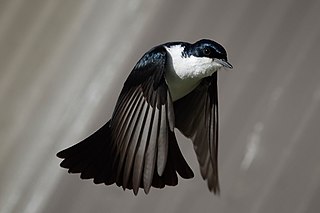
The restless flycatcher or restless myiagra is a passerine bird in the family Monarchidae; it is also known as the razor grinder or scissors grinder because of its distinctive call. It is a native of eastern and southern Australia. Populations in New Guinea and northern Australia, which were at one time considered to be a subspecies, are now accepted as a separate species, the paperbark flycatcher. It is a small to medium-sized bird and has similar colouring to the willie wagtail.

Rück's blue flycatcher is a passerine bird in the Old World flycatcher family Muscicapidae. It is known from only four specimens and is endemic to a small area in northeast Sumatra, Indonesia, inhabiting primary lowland forest. Although all specimens share common characteristics, such as a black bill, brown iris, and black feet, two of the collected specimens show some physical discrepancy with the other two. They were initially described as Cyornis vanheysti before being accepted as specimens of C. ruckii. Rück's blue flycatcher has also been compared to other species of Cyornis.
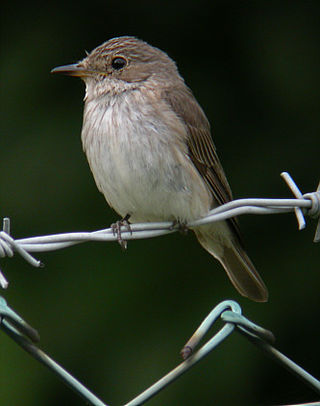
Muscicapa is a genus of passerine birds belonging to the Old World flycatcher family Muscicapidae, and therein to the typical flycatchers of subfamily Muscicapinae. They are widespread across Europe, Africa and Asia with most species occurring in forest and woodland habitats. Several species are migratory, moving south from Europe and northern Asia for the winter.

The Benguela long-billed lark, also known as the Benguela lark or Benguela longbill is a species of lark in the family Alaudidae. It is found in south-western Africa. Its natural habitat is subtropical or tropical dry lowland grassland.

The Cape long-billed lark, also known as the Cape lark, Cape longbill or long-billed lark is a species of lark in the family Alaudidae. It is found in south-western Africa. Its natural habitats are semi-arid Karoo shrub and subtropical dry shrubland and subtropical or dry lowland and highveld grassland. This lark is also found in croplands, farmlands and coastal fynbos.

The spike-heeled lark is a species of lark in the family Alaudidae. It is found in southern Africa.

The white-tailed shrike-tyrant is a species of bird in the family Tyrannidae. It is found in Argentina, Bolivia, Chile, Ecuador, and Peru. At 25–28 cm (10–11 in) long, it is a very large flycatcher, second only to the great shrike-tyrant in size.

The smoke-colored pewee is a species of bird in the family Tyrannidae. The species is characterized by a uniform dusky-grey plumage.
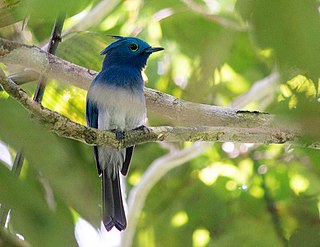
The celestial monarch is a species of bird in the family Monarchidae, and one of the most attractive of all the monarch flycatchers, with its spectacular blue crest and large greenish-yellow wattle. It is endemic to the Philippines with its extant range being in Luzon, Samar, Mindanao Tawi-Tawi and Basilan and it being possibly extinct on Negros and Sibuyan Island. It is often observed in mixed flocks with other birds such as blue fantails, rusty-crowned babblers, rufous paradise flycatchers, both short-crested monarchs and black-naped monarchs and other small forest birds. Its natural habitat is tropical moist lowland forests up to 750 masl. It is one of the most sought after birds by birdwatchers in the Philippines and in the world.
The short-crested monarch is a species of bird in the family Monarchidae. It is endemic to the Philippines. It is found in tropical moist lowland forest. It is threatened by habitat loss.
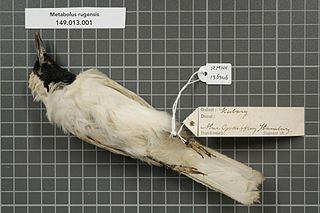
The Chuuk monarch, or Truk monarch, is a species of bird in the family Monarchidae. It is monotypic within the genus Metabolus. It is endemic to the island of Chuuk in Micronesia.
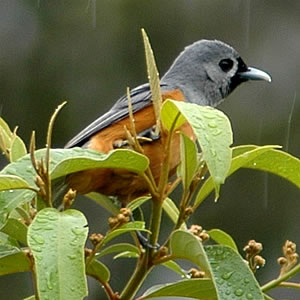
Monarcha is a genus of bird in the family Monarchidae. They are found in Australia and Melanesia.
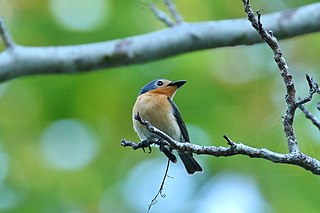
The Palau flycatcher is a species of bird in the family Monarchidae. It is endemic to Palau.
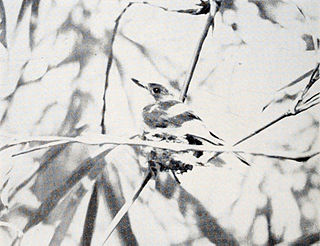
The Guam flycatcher, or Guam broadbill, is an extinct species of bird in the family Monarchidae formerly endemic to Guam.

The oceanic flycatcher is a species of bird in the family Monarchidae. It is endemic to Micronesia and can be found on the Caroline Islands. The diversity of traits in the Oceanic flycatchers resulted from three waves of colonization in non-overlapping times, which led to situ specification events on Micronesian islands.
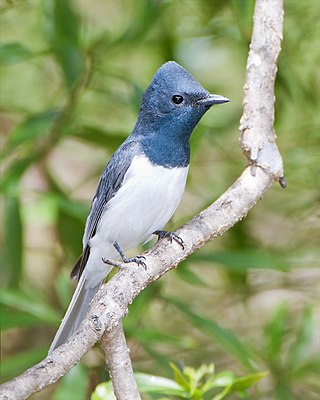
The leaden flycatcher is a species of passerine bird in the family Monarchidae. Around 15 cm (6 in) in length, the male is lustrous azure with white underparts, while the female possesses leaden head, mantle and back and rufous throat and breast. It is found in eastern and northern Australia, Indonesia, and Papua New Guinea. Its natural habitat is subtropical or tropical mangrove forests in the northern parts of its range, in the south and inland it is eucalypt woodland.

Bates's paradise flycatcher is a passerine bird belonging to the monarch-flycatcher family, Monarchidae. The sexes are similar in appearance with the upper parts being rufous and the head and underparts being bluish-grey. It is native to central Africa where it is found in the understorey of forests.
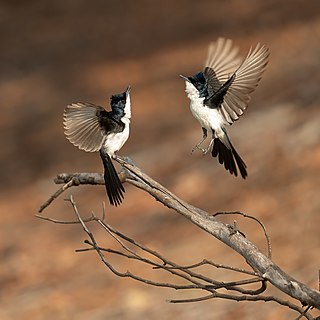
The paperbark flycatcher, also known as the little restless flycatcher, is a passerine bird in the family Monarchidae. It occurs in tropical woodland and riverine habitats of northern Australia and southern New Guinea. Previously, some authorities lumped the paperbark flycatcher as a distinctive subspecies of the restless flycatcher of southern and eastern Australia, with which it forms a superspecies.





















